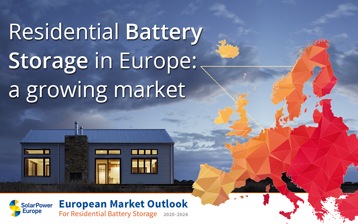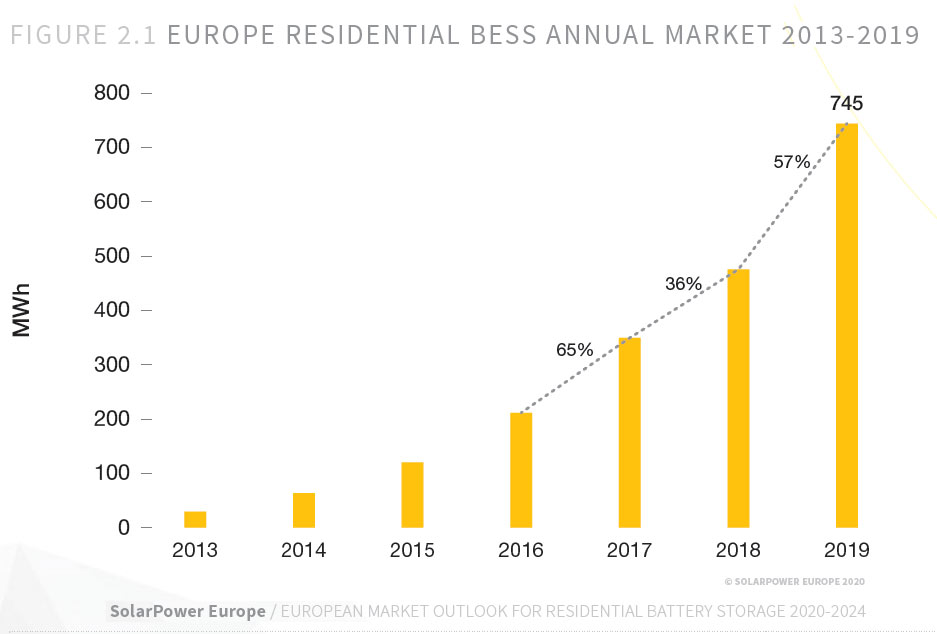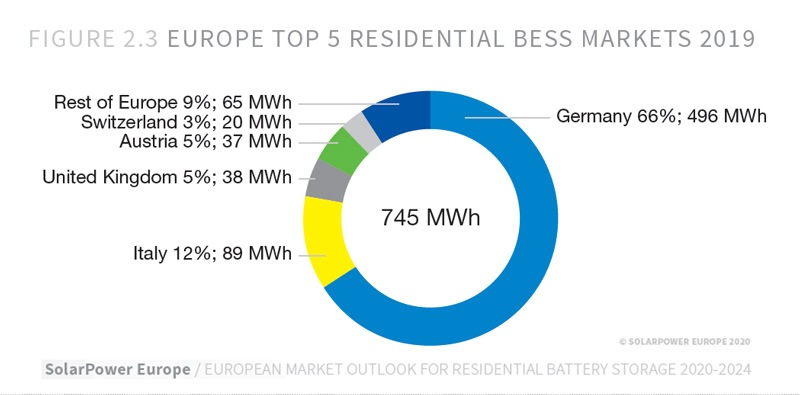The residential storage market is born in 2013 in Germany after the closure of the feed-in-tariff, due to other mechanisms that encouraged self-consumption.
The first residential storage systems came to life in the two main European markets in the following years and up to 2017 Germany, Italy and the United Kingdom were responsible for 90% of the installations.
The 2% of this photovoltaic systems had batteries. Subsequently Austria, France and Switzerland also entered the market.
Installed in Europe almost 96,000 residential storage systems
During 2019 it has been installed in Europe almost 96,000 residential storage systems, for a total of approximately 745 MWh of capacity with a growth rate of 57% compared to the previous year. These data are contained in the new European Market Outlook For Residential Battery Storage 2020–2024 published by SolarPower Europe.
Almost 90% of all these systems have been installed by 5 countries: Germany, Italy, United Kingdom, Austria and Switzerland, which, as said before, have been protagonist of the market in the previous years.
Growth of 9% in 2020
We know, 2020 is marked by the pandemic of COVID-19. As confirmed by Solar Power Europe, thanks to some incentives issued to some key countries such as Italy, Germany and Switzerland, the photovoltaic market grew by 9%.
Greater self-consumption and incentives at the national or local level
The increase can be rated from two points of view. From the emotional one, it has been given by the homeowners who have seen the incentive rates disappear slowly and have been pushed towards self-consumption.
From the other point of view, the economic one, the increase has been given by a lower cost of self-produced energy from a photovoltaic system with respect to the purchase from the grid and by a rapid decrease in the costs of storage systems.
With the hope of a regression of the pandemic from 2021, the growth rate is expected to return to double digits.
Projections 2022 are expected to around 140.000 new storage systems per year
One of the most probable scenarios brings up to 1 GWh of cumulative capacity by 2022 which is equivalent to about 140,000 new systems per year. By 2024, in the rosiest scenario, could be reached cumulative 9 GWh, while in the more restrictive one 5.6 GWh.
Germany and Italy the main European markets for storage
The bulk of the installations between now and 2024 will continue to be in Germany, while Italy, second in this ranking, will be some distance away.
Depending on the incentives that will be put in place, Austria and England will play for third place, while Switzerland will remain in fifth place.
Objectives of the European Community
To achieve the ambitious objectives of the European Community towards the energy transition, many tools will have to be put in place, both political incentives but also technical ones.
This is because national and transactional electricity grids will have to support an increasing number of photovoltaic systems with distributed batteries.








